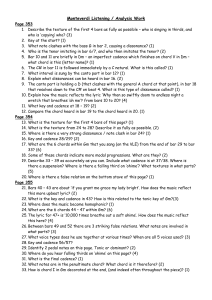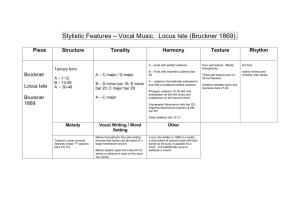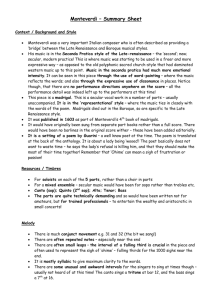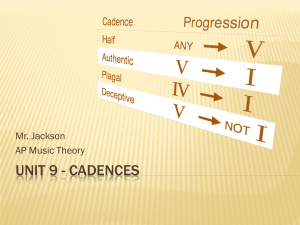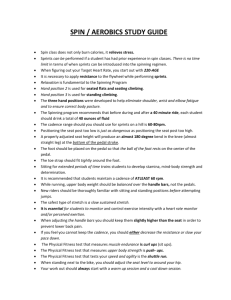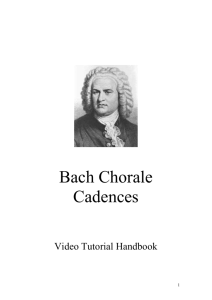Cadences 192KB Nov 29 2015 04:10:56 PM
advertisement
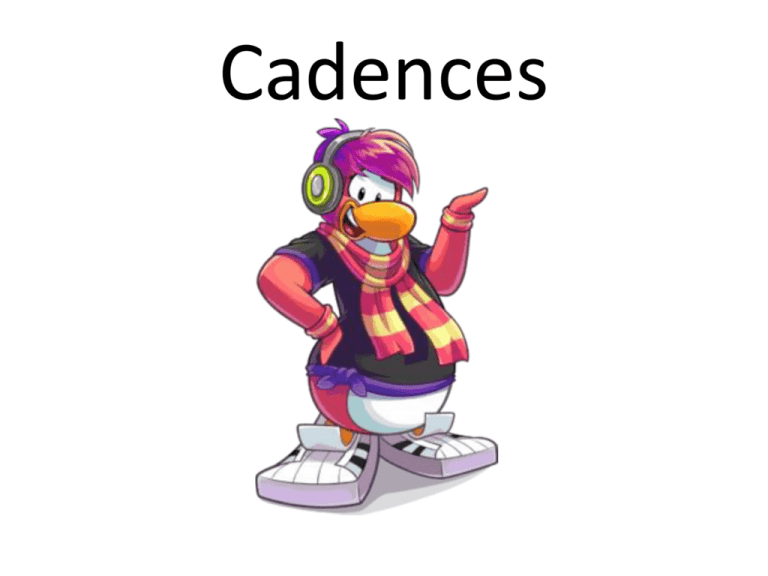
Cadences
Why we need Cadences
• A cadence is where the music reaches some kind
of goal – often accompanied by a rhythmic pause.
• The music between cadences is called a phrase.
• Cadences separate phrases and act very much
like grammatical periods while musical phrases
are like grammatical sentences.
• These devices are important in musical structure
because they divide the music into smaller, bitesized, manageable pieces.
Why we need Cadences
• A harmonic cadence is a progression of (at least)
two chords that concludes a phrase, section,
or piece of music.
• A rhythmic cadence is a
characteristic rhythmic pattern that indicates the
end of a phrase. A cadence is labeled more or
less "weak" or "strong" depending on its sense of
finality.
Why we need Cadences
• While cadences are usually classified by specific
chord or melodic progressions, the use of such
progressions does not necessarily constitute a
cadence—there must be a sense of closure.
• Harmonic rhythm plays an important part in
determining where a cadence occurs.
Perfect Cadence
• Dominant (V, V⁷) to Tonic (I or i) harmonic motion
is the strongest and most common type of
cadence because it returns (re-stabilizes) the
music back to the home (tonic) chord.
• Subtle degrees of strength can be determined by
the inversion of the chords (root position is the
strongest) or the melodic scale degree (the root is
the strongest). V/V⁷ /vii ˚ → I/i
• A seventh is sometimes added to the dominant
chord (V7), but the seventh must resolve to the
third of the tonic.
Perfect Cadence
• An example of an Authentic Perfect Cadence
in C major:
Plagal Cadence
• Subdominant (IV or iv) to Tonic (I or i) harmonic
motion: strong because it goes to the tonic, but not as
strong as the authentic cadence because the motion is
"less progressive" (down by a 4th) and because there is
no leading tone in the IV/iv chord. IV/iv → I/i
• Although the cadence ends on the tonic chord, the
subdominant is less powerful than the dominant as a
chord preceding the tonic.
• It is sometimes called the "Amen" cadence, as the
cadence would often appear in hymns to the words
'amen'.
Plagal Cadence
• An example of a plagal cadence (IV - I) in C
major:
Imperfect (half) Cadence
• An imperfect/half cadence is a cadence which
leads to the dominant chord, but doesn't have
a finished feel.
• The chord that precedes the dominant chord
is often a choice of: I (tonic); II (Supertonic); IV
(Subdominant) or VI (SubMediant), although
other chords do occur.
Imperfect Cadence
• An example of an Imperfect/Half Cadence (I V) in C major:
Imperfect Cadence
• There is a specific type of imperfect/half
cadence known as the 'Phrygian cadence'.
• The descending semitone in the base
resembles that of the flattened supertonic tonic movement of the phrygian mode.
• The Cadence happens in minor keys, with the
progression ivb- V.
Imperfect Cadence
• An example of a Phrygian Cadence (ivb- V) in C
minor:
Deceptive Cadence
• An interrupted/deceptive cadence is a chord
progression from the dominant to any chord
other than the tonic.
• When the dominant is heard, a perfect/authentic
cadence (V-I) is expected, so the next chord
interrupts the music or deceives the listener.
• The Interrupted/deceptive cadence is thought of
as a weak cadence harmonically, but can have a
dramatic effect.
Deceptive Cadence
• An example of an interrupted/deceptive
cadence in C major (V - vi):
The Cadential 6/4
• The cadential 6/4 ('six - four') is the name
given to a common three chord cadence.
• Third inversion chords are labelled in figured
bass as '6/4' chords, hence the name
'cadential 6/4'.
• It is thought to be a function of the dominant
chord. Hence, some people label the
progression 'V6/4 - 5/3I'.
The Cadential 6/4
• An example of a cadential 6/4 in C major:
I6/4 –
V
I


